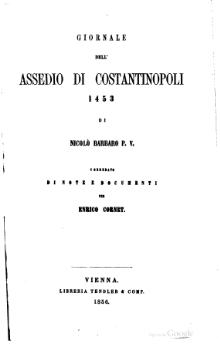|
Nicolò Barbaro Nicolò Barbaro, son of Marco, (1427–28 – c. 1521) was a Venetian nobleman and author of an eyewitness account, written in Venetian vernacular, documenting the Ottoman siege and conquest of Byzantine Constantinople in 1453, also known as the Fall of Constantinople.[1][2] In his account, Barbaro refers to himself as the medic of the galleys (“el miedego dele galie”),[3] and is often referred to in scholarship as the ship’s doctor or physician. However, recent research suggests that he served as a crossbowman on the annual mercantile convoy to Constantinople that year, a role he is thought to have held on other convoys before and after 1453. It is unclear whether he performed both functions on the voyage to Constantinople, and the reason for his self-reference as a medic alone remains unknown, as his reconstructed curriculum vitae shows no indication of medical training or career.[4] Born in 1427 or 1428, Barbaro was not yet 25 years old when he became involved in the defense of Constantinople. He was related by blood to the captain of the mercantile convoy, Alvise Diedo, son of Marco, who is frequently mentioned in his account.[5] Historian Steven Runciman described Barbaro as "the most useful of the Western sources"[6] on the fall of the city, largely due to his detailed narrative that recounts the events of the siege on a daily basis. However, Barbaro’s Venetian background influenced his views, particularly his strong anti-Genoese sentiments, especially toward the Genoese of Pera (modern-day Galata), whom he accused of collaborating with the Ottomans during the siege.[7] Barbaro also alleged that Zuan Zustignan, the Genoese commander stationed at the Mesoteichion (Μεσοτείχιον, "Middle Wall"), the weakest section of the Theodosian Walls, abandoned his post, leading to the city's fall: "Zuan Zustignan, that Genoese of Genoa, decided to abandon his post and fled to his ship, which was lying at the boom. The Emperor [Constantine XI] had made this Zuan Zustignan captain of his forces, and as he fled, he went through the city crying 'The Turks have got into the city!' But he lied through his teeth, because the Turks were not yet inside."[8] Another eyewitness, Leonard of Chios, however, reported that Zustignan was injured by an arrow and secretly sought medical assistance.[9] Greek historians Doukas and Laonikos Chalkokondyles similarly stated that Zustignan was injured, with only Barbaro claiming that the Genoese commander fled in this manner.[10][11] Despite these criticisms, Barbaro's account remains valuable for its detailed, day-by-day chronology of the siege events and for providing the names of over 100 Venetians who were in Constantinople at the time. Barbaro is believed to have completed the initial writing of his narrative by 1472 but continued working on the manuscript for decades, updating it with information on Venetian noblemen present during the siege who had since died. Evidence suggests he stopped working on the manuscript sometime between 1503 and 1507.[12] Barbaro may have been the last surviving Venetian nobleman involved in the 1453 defense, reportedly dying in 1521.[13][14] References
|
Portal di Ensiklopedia Dunia